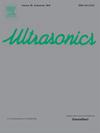A new FEM-based approach on the modeling of stress-induced velocity shift of piezoelectric surface acoustic wave resonators
IF 3.8
2区 物理与天体物理
Q1 ACOUSTICS
引用次数: 0
Abstract
A novel methodology is introduced for the computation of stress-induced surface acoustic wave velocity shifts in piezoelectric resonators including quartz, lithium niobate and langasite resonators. The numerical framework has been verified through a comparative analysis of experimental and Finite Element Method (FEM) results for quartz resonators. This approach introduces the combined capabilities of COMSOL Multiphysics and MATLAB, facilitated by LiveLink, to systematically calculate all parameters contributing to the perturbation integral. The findings have a better accuracy using the LiveLink methodology in this study compared to prior approaches that rely on average stress and strain calculations in the central point of the resonator. Moreover, the utilization of LiveLink not only enhances accuracy but also establishes MATLAB as a fundamental software platform for interfacing with COMSOL Multiphysics. The proposed approach in this paper can extend to complex strain sensors or investigations into the influence of temperature and imbalanced loading effects in future research endeavors. Furthermore, the LiveLink approach introduced herein can be extended to optimize crystal orientation and identify premium wave directions, thereby contributing to the enhanced design of Surface Acoustic Wave (SAW) resonators. This innovative methodology is used to advance the understanding and application of stress-induced velocity shifts in SAW devices, presenting future developments in sensor technologies and resonator designs. © 2024 Elsevier Science. All rights reserved.
基于有限元法的压电表面声波谐振器应力速度位移建模新方法
介绍了一种计算石英、铌酸锂和langasite等压电谐振腔中应力引起的表面声波速度位移的新方法。通过对石英谐振器的实验结果和有限元分析结果的对比分析,验证了数值框架的正确性。该方法引入了COMSOL Multiphysics和MATLAB的组合功能,并由LiveLink提供支持,可以系统地计算影响微扰积分的所有参数。与之前依赖于谐振器中心点的平均应力和应变计算的方法相比,在本研究中使用LiveLink方法的结果具有更好的准确性。此外,利用LiveLink不仅提高了精度,而且使MATLAB成为与COMSOL Multiphysics接口的基本软件平台。本文提出的方法可以在未来的研究工作中扩展到复杂的应变传感器或研究温度和不平衡负载效应的影响。此外,本文介绍的LiveLink方法可以扩展到优化晶体取向和识别优质波方向,从而有助于增强表面声波(SAW)谐振器的设计。这种创新的方法用于推进SAW器件中应力引起的速度变化的理解和应用,展示了传感器技术和谐振器设计的未来发展。©2024爱思唯尔科学版权所有。
本文章由计算机程序翻译,如有差异,请以英文原文为准。
求助全文
约1分钟内获得全文
求助全文
来源期刊

Ultrasonics
医学-核医学
CiteScore
7.60
自引率
19.00%
发文量
186
审稿时长
3.9 months
期刊介绍:
Ultrasonics is the only internationally established journal which covers the entire field of ultrasound research and technology and all its many applications. Ultrasonics contains a variety of sections to keep readers fully informed and up-to-date on the whole spectrum of research and development throughout the world. Ultrasonics publishes papers of exceptional quality and of relevance to both academia and industry. Manuscripts in which ultrasonics is a central issue and not simply an incidental tool or minor issue, are welcomed.
As well as top quality original research papers and review articles by world renowned experts, Ultrasonics also regularly features short communications, a calendar of forthcoming events and special issues dedicated to topical subjects.
 求助内容:
求助内容: 应助结果提醒方式:
应助结果提醒方式:


